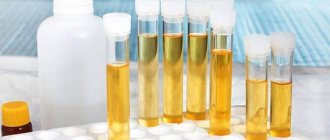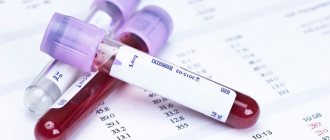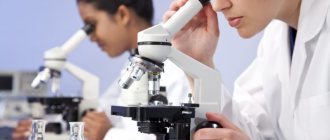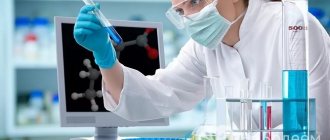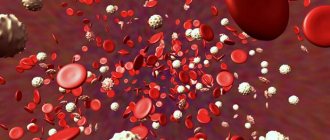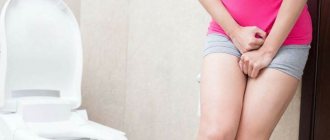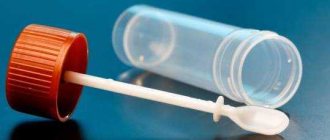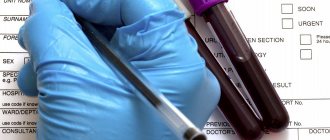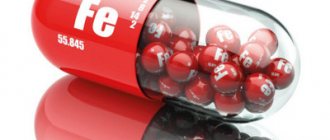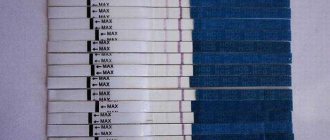A general urine test is considered a standard procedure prescribed for both therapeutic and preventive purposes. It is carried out free of charge. If any deviations in the decoding of indicators indicating disturbances in the composition of urine are detected, there is a need to conduct additional laboratory tests. One of them is urine analysis according to Nechiporenko. Its implementation makes it possible to detect pathological changes in the urinary system, clarify the clinical picture and more accurately diagnose the problem.
What does urine analysis according to Nechiporenko show?
We list the indications for performing the test:
- asymptomatic increase in temperature reaction;
- the need for condition dynamics during treatment;
- the appearance of cylinders in a general urine test;
- developmental abnormalities of the urinary organs;
- borderline values of elements in a general urinalysis;
- increased levels of urea and creatinine;
- pre-pregnancy examination;
- clinical observation of a patient with urological or nephrological pathology;
- pathological changes diagnosed by ultrasound examination;
- no changes in urine at the appropriate urological clinic.
When examining 1 ml of urine, the number of red blood cells, leukocytes, and casts is calculated.
Leukocytes are blood cells that provide the body's immune defense, and they are also the main markers of the inflammatory process. An increase in leukocytes in the urine indicates inflammation in the urogenital tract.
Normally, leukocytes in a general urine analysis are single, i.e., they do not exceed 2–3 per field of view in men, and 4–6 in women.
If the number of leukocytes in a man’s urine is 5–7 or higher, a Nechiporenko test and a smear from the urethra are examined.
Red blood cells in the urine can be a consequence of any vascular damage due to urolithiasis, crystalluria, tumor disintegration, or occur with immune damage to the structural apparatus of the kidneys, for example, with glomerulonephritis with hematuric syndrome.
Cylinders are protein bodies that appear during pathological processes in the renal tubules.
The following cylinders are distinguished:
granular (appears against the background of tubule lysis);
hyaline (formed from the protein of primary urine);
erythrocyte (appear against the background of erythrocyte occlusion of the renal tubules),
waxy (based on hyaline or granular casts stagnant in the renal tubule);
epithelial (desquamated epithelium of the renal tubule).
Note that hyaline casts can be present in the urine in quantities of up to 20; if other casts are detected, this is considered a deviation from the norm.
What is the analysis technique?
In cases where a general clinical examination reveals pathological changes, the Nechiporenko test is used. It has greater specificity and allows you to confirm or exclude renal disease. It is advisable to know what urine analysis according to Nechiporenko shows in order to understand the reasons for establishing simple but fairly strict rules for collecting the analysis.
The purpose of this technique is:
- if a general clinical analysis reveals a high content of leukocytes or erythrocytes,
- if a general urine test (UCA) showed the presence of cylinders,
- if there is a suspicion of pathological processes occurring in the organs of the urinary system,
- in cases of monitoring ongoing treatment.
How to correctly collect a urine test according to Nechiporenko
note
It should be noted that the results of a urine sample according to Nechiporenko will be unreliable if a woman has colpitis (inflammation of the vagina). In this case, leukocytes from the vagina enter the urine, which does not allow a correct diagnosis to be made.
In doubtful situations, to confirm or exclude an inflammatory process in the urinary tract, urine is collected for analysis using bladder catheterization on an outpatient basis. Some experts advise simply inserting a sanitary tampon into the vagina.
If urethritis is present in a man, there is no point in confirming the obvious (leukocyturia) using the Nechiporenko test.
Important
To get the most reliable results, you should stop drinking alcohol, carbonated drinks, excessive consumption of protein products (meat, milk, fish, eggs), and smoked foods for about 24 hours. You should refrain from intense workouts and sauna visits.
When taking antibiotics and anti-inflammatory drugs, there is a possibility of incorrectly assessing the condition of the urinary tract: the process of inflammation itself will develop, but there will be no pathological changes in the urine.
During menstruation, you should not examine urine according to Nechiporenko , since if blood gets into the urine, microhematuria will be false, and such a result has no diagnostic value.
To increase accuracy, it is better to take urine for analysis 3 to 4 days after the end of menstruation.
The result will also be unreliable if there is bleeding from the genital tract, for example, after childbirth or as a result of ovarian dysfunction.
Before collecting the analysis, it is necessary to toilet the external genitalia, lather the intimate area with soap and rinse with water . Then blot your genitals with a towel (do not rub), flush about 1/3 of the urine into the toilet, then into a specially prepared container (can be bought at a pharmacy), and back into the toilet.
Before collecting urine, men must retract the foreskin and wash off the smegma.
You should not store collected urine for a long time, as pathogenic bacteria can multiply in it. Ideally, the container is delivered to the laboratory no later than 2 hours from the moment of collection.
Testing by a child
In order to collect urine according to Nechiporenko for a baby, some effort is required. The child must be washed without using soap. Parents of a sick child need to know how to properly take a urine test according to Nechiporenko. It is possible to use a urine bag. This is one of the solutions to the problem of how to collect urine. To do this, you need to secure it to the genitals of the washed baby and wait for the moment of urination. If there is no urine bag, you can place the child on a clean oilcloth and wait for the moment when a stream of urine appears. All you need to do is place the existing container in time, where the parent will collect the liquid.
In this case, to start reflex urination, it is possible to use stroking a small child along the spine, but if the child is older than a year, then the sound of flowing water from a tap will help. When taking the test to the clinic, you must be warned that the sample is morning urine, which includes three streams. Urinalysis according to Nechiporenko takes one day to prepare.
How to properly collect urine from a child
Before collecting, carry out hygiene procedures, and it is important to wash the girl from front to back so as not to spread the intestinal microflora.
There are 2 options:
The first is to attach a urine bag purchased at a pharmacy to the child’s genitals and wait for the natural act of urination.
The second is to put the baby on a diaper, using reflex stimulation (stroking the spine, the sound of pouring water) to stimulate the act of urination. A container for collecting urine must be prepared in advance.
Warn your pediatrician that the entire urine is being submitted for analysis.
How much urine should be collected
Of course, the volume of urine produced may differ from person to person - it depends on the drinking regime, the frequency of emptying the bladder, the characteristics of the body, and diseases (for example, cystitis forces a person to urinate in small portions).
Sometimes the amount of collected urine is so small that it is impossible to conduct a study - the laboratory cannot evaluate its composition, and therefore the urine has to be collected again. A reasonable question arises - how much urine is needed for analysis.
The volume required depends on the specific analysis. Typically, 50–100 ml of urine is taken for testing; a laboratory technician will be able to analyze this amount. There are studies for which urine is collected for analysis all day, then the volume of urine collected can reach 2 liters.
How much urine is needed for analysis in newborns: 5–10 ml, approximately the amount of urine a baby produces at one time. Of course, it will not be easy for doctors to work with such a volume, but it is possible to conduct research.
How the Nechiporenko test is deciphered: norm and pathology
Normal values in children and adults are identical.
Leukocytes up to 4000/ml (according to some sources - up to 2000/ml);
Red blood cells up to 1000/ml;
Cylinders 0 - 1 for 4 Goryaev chambers, or 0 - 1 for Fuchs - Rosenthal chamber.
Important
Even if you receive the result of the Nechiporenko test with data different from the norm, do not rush to make a diagnosis yourself, only a doctor can judge what is normal and what is pathology.
What is it prescribed for?
As described above, the Nechiporenko research method is used as a diagnostic one. It is usually prescribed after a general analysis (if any deviations were identified in the indicators) in order to obtain a more detailed picture from the collected data for making a diagnosis.
Deviation from normal readings indicates the presence of a disease
This analysis is also done to monitor the effectiveness of the therapy. The data is interpreted as follows:
- The norm of leukocytes is up to 2000 per 1 ml; if there are more of them, then an inflammatory process occurs. Increased levels are observed with prostatitis, pyelonephritis, urolithiasis, and cystitis.
- The norm of red blood cells is up to 1000 in 1 ml. If the readings are higher, then there is every reason to suspect serious inflammation with bleeding.
- According to the established norm, 1 ml of urine can contain up to 20 hyaline casts. If more of them are found, then inflammation is probably actively developing in the renal pelvis.
What does an increase in elements in the Nechiporenko sample indicate?
note
It should be noted that some practicing urologists consider the number of leukocytes 4000/ml in the Nechiporenko test in men to be overestimated and does not exclude an inflammatory process, which requires further examination or follow-up.
We present to your attention the nosologies in which changes in urine appear according to Nechiporenko.
Elevated red blood cells:
- Uronephrolithiasis;
dismetabolic nephropathy;
- systemic diseases;
- glomerulonephritis;
- bruise or injury to the kidney;
- fornical bleeding while taking hormonal drugs;
- taking blood thinning medications;
- NSAIDs - nephropathy,
- tumor neoplasms of the urogenital tract;
- nephrotic syndrome;
- polycystic disease;
- genitourinary tuberculosis.
Increased leukocytes:
- inflammatory diseases of the kidneys, bladder, urethra, prostate gland;
- in women, improper collection of urine due to colpitis, prolapse of the anterior vaginal wall;
- systemic diseases;
- secondary inflammatory process against the background of nephrolithiasis, tumor, diverticulum, cystocele, etc.
Hyaline casts are present:
- infectious bacterial kidney damage;
- hypertension;
- glomerulonephritis;
- abuse of diuretics.
Waxy cylinders:
- kidney amyloidosis;
- chronic renal failure;
- nephrotic syndrome.
Epithelial casts:
- viral and toxic kidney damage;
- acute phase of tubular necrosis.
Red blood cell casts:
- long-term hypertension without response to drug correction;
- occlusion of renal vessels by thrombus;
- kidney infarction;
Grain cylinders:
- infectious inflammatory process in the kidneys;
- lesions of the glomerular apparatus;
- viral kidney damage;
- toxic effects of lead.
Let us note that it is impossible to make a diagnosis based on one analysis according to Nechiporenko, therefore a variety of examination methods are used: laboratory and instrumental.
Victoria Mishina, urologist, medical columnist
13, total, today
( 40 votes, average: 4.78 out of 5)
Ultrasound of the heart: preparation, indications, what can be detected
Blood test for the NSE tumor marker - when is the test prescribed?
Related Posts
Casts in urine and related diseases
Cylinders are protein conglomerates; they form in the renal tubules and take their shape. Laboratory diagnostics identifies several types of casts: epithelial, granular, waxy, erythrocyte and hyaline. Normally, urine contains only hyaline casts, and the appearance of other types is regarded as a serious pathology.
Increasing values
Hyaline (formed from proteins):
- acute or chronic pyelonephritis/glomerulonephritis;
- kidney damage due to hypertension;
- long-term therapy with diuretics;
- overdose of diuretics;
- nephrotic syndrome and proteinuria;
- chronic renal failure;
- congestive heart failure;
- diabetic nephropathy.
- intense physical activity
Granular casts in urine (formed from destroyed leukocytes):
- glomerulonephritis (acute phase);
- pyelonephritis due to urolithiasis, including malignant;
- intoxication of the body with salts of heavy metals;
- structural changes in the kidneys and associated hydronephrosis (impaired urine outflow from the kidneys);
- the presence of viral, bacterial, infectious and inflammatory processes;
- autoimmune pathologies (rheumatoid arthritis);
- toxicosis of pregnant women.
Presence of waxy cylinders (degenerated granular):
- nephrotic syndrome;
- structural and organic changes in the kidneys;
- kidney amyloidosis (deposition of a specific protein-polysaccharide complex - amyloid);
- functional kidney failure in chronic form;
- diabetic nephropathy;
- kidney transplant rejection.
Epithelial casts (formed from the epithelium of the renal tubules):
- general intoxication of the body;
- viral or bacterial diseases;
- tissue death (necrosis) of the renal tubules in acute form;
- overdose of drugs that affect kidney function;
- heavy metal poisoning;
- eclampsia;
- glomerulonephritis.
Red blood cells:
- hypertension in crisis stage;
- renal vascular thrombosis;
- kidney infarction;
- glomerulonephritis in the acute phase;
- surgical interventions or injuries of the genitourinary system;
- kidney tuberculosis;
- vaginal infections.
In addition, the presence of various types of casts in the urine may be a sign of:
- cardiovascular pathology;
- epilepsy;
- liver diseases (cirrhosis, viral hepatitis);
- gout (disease of tissues and joints);
- complicated pregnancy;
- terminal state.
- Edgar V Lerma, MD. Urinalysis. Dec 15, 2015 // English-language database of current medical data Medscape.
- Danilova L. A. Tests of blood, urine and other biological fluids at different age periods. — St. Petersburg: Spets-Lit, 2019.
Determination of organic elements in the laboratory
Analysis according to Nechiporenko is done according to an algorithm. First, the acid-base environment of urine is determined. An alkaline environment sometimes indicates the decomposition of formed elements. After determining the pH of the urine, 10 ml of the test material is poured and centrifuged for 3 minutes. Thus, the top layer is separated from the sediment. Normally, the sediment should be 0.5 - 1 ml. It is thoroughly stirred and placed in a counting chamber.
If the count is carried out in Goryaev's chamber, the following technique is used:
- The exact number of red blood cells, leukocytes and cylinders is obtained by calculating using the formula: the number of formed elements that were counted in the chamber is divided by the volume of the chamber in μl (in Goryaev’s device this figure is 0.9).
- After establishing this indicator, the amount of each formed element in 1 ml of urine is calculated: the number of elements in 1 μl of urine with sediment is multiplied by the volume of urine with sediment and divided by the amount of urine that was taken for centrifugation.
This technique allows you to give accurate and informative results. If the patient does not know how to submit material for research correctly, the risk of false readings increases. However, the accuracy of laboratory diagnosis depends not only on how the patient collects urine, but also on compliance with the counting algorithm.
Often the technique is used to accurately identify pyelonephritis or glomerulonephritis. Determination of the formed elements in 1 ml of material also provides information about the presence of urolithiasis in the patient, toxicosis in pregnant women, arterial hypertension, and heart failure. Normally, the number of red blood cells does not exceed 1000 per ml of urine, leukocytes - no more than 2000 per 1 ml, and cylinders - no more than 20 per 1 ml. Exceeding these indicators indicates illness or improper urine collection.
How should I prepare a sample for analysis?
According to Nechiporenko’s method, a midline urine sample is collected. To do this correctly, you need to follow simple rules:
- On the eve of submitting a urine sample for examination, you should make sure that your diet does not contain spicy, salty, fatty foods or foods containing strongly coloring pigments, such as beets, carrots, blackberries, and the like. Some medications can also strongly color urine, so it is advisable to refrain from taking them. The period that elapsed between the last intake of these products and the test must be at least 12 hours;
- It is critically important to refrain from taking diuretics for 2 days before collecting a sample for analysis;
- Collect urine in the morning, with preliminary washing of the genitourinary organs and preferably without soap;
- An average portion of urine must be taken into a clean container or a special pharmaceutical container, and after collection, transported to the laboratory;
- Storage conditions for the analysis should be in a cool, unlit place, no more than two hours.
Procedure
How long does it take to perform a urine test according to Nechiporenko? The average duration of a diagnostic study of collected urine is 10-12 minutes. Experienced specialists who have worked in a biochemical laboratory for over 5 years can identify urine indicators in an even shorter time. In general, the research algorithm consists of the following stages:
- at least 10 milliliters of collected urine is poured into a sterile graduated test tube (the laboratory assistant shakes the biological material so that initial mixing of the liquid occurs);
- the test tube is placed in a centrifuge chamber, where it rotates for the next 3 minutes with a load force of 3500 rpm;
- after the specified time, the test tube is removed from the chamber and placed on the research table;
- Using a pipette, the specialist removes the top layer of urine, leaving at least 1 milliliter of urine in the container;
- the residual sediment is thoroughly mixed by shaking the test tube, and then placed in a device called a Burker chamber, which is also called a counting chamber;
- in this chamber, an electronic count of the quantitative composition of leukocytes, erythrocytes and cylindrical bodies of all types is carried out.
If necessary, the results of separate counting of cellular material obtained using an electronic device can be double-checked using medical formulas, the appropriateness of which depends on the clinical situation. Previously, modern technology was not used in urine analysis according to Nechiporenko, and the identification of cell sediment was carried out using a microscope. In medical institutions that lack modern equipment, urine tests are carried out using old methods.
Urinalysis according to Nechiporenko can be performed on patients of all age groups. In young children, urine collection is carried out by parents using a special urinal device. Adults can urinate at home and bring the tests to the laboratory, where biological material will be examined, or they can give urine according to Nechiporenko in the hospital if the patient is receiving drug therapy in a hospital.
Indications
The algorithm for urine collection according to Nechiporenko in children is not complicated, and will be written about it in detail below. Initially, it is necessary to understand for what purposes pediatricians advise undergoing this study. During laboratory diagnostics, biological material is assessed according to the following parameters: color, specific gravity, acidity and transparency. The chemical composition, identification of protein and sugar are also subject to study.
In addition, urine analysis in children according to Nechiporenko makes it possible to study in detail the composition of the sediment, confirm or refute the presence of flat epithelial cells, bacteria, salt crystals and mucus in it. If urine collection was carried out correctly according to Nechiporenko in children, then the quantitative composition of blood cells and their proportional ratio will be assessed.
The main indication for laboratory diagnostics is the doctor’s suspicion that the child has developed diseases of the genitourinary system of a chronic nature that occur in a latent form, as well as the identification of infectious microorganisms, which are determined by the presence of leukocytes, casts, bacteria and mucus.
When answering the question about what urine according to Nechiporenko shows in children, doctors draw attention to the fact that the study makes it possible to determine the degree of severity and the approximate area of localization of the pathological focus. If the values are significantly higher than normal, problems with the kidneys, dysfunction of the bladder and urethra cannot be ruled out.
Technique for proper urine collection
As soon as the child wakes up, he is given a thorough toilet of the genitals (this is done at any age, even in infants). To do this, wash the child under warm running water from the tap or use wet antiseptic wipes.
Boys are treated well with the penis and scrotum, and girls are washed from the vaginal lumen towards the anus
The further algorithm of the activities carried out is as follows:
- in order to collect urine, use a sterile container, which is prepared in advance;
- Older children are explained that they must first urinate in the toilet and collect the middle portion of urine in this container;
- if it concerns children under one year old, then it is permissible to give the entire portion of urine, which is collected using a urine bag, and then part of it is poured into a sterile container;
- the container is closed with a lid tightly enough to avoid possible leakage of urine and its contact with the surrounding air;
- Next, the analysis is transported to the laboratory.
Indications for use
If dangerous changes are observed in a clinical study, an accurate diagnosis can be made through the Nechiporenko study.
Why it is carried out:
- To identify inflammatory processes in the urinary system (urethritis, cystitis, pyelonephritis).
- To assess kidney damage in a number of systemic diseases (systemic lupus erythematosus).
- For a more accurate diagnosis of diseases of the urinary system.
- To monitor the treatment of pathologies of the urinary organs.
In what cases is it indicated:
- For symptoms of diseases of the urinary system (changes in color, clarity of urine, pain during urination).
- If there are deviations in the overall analysis.
- For systemic diseases in which there is a risk of kidney damage.
- As a preventive measure.
- It is not prescribed to absolutely everyone. If the general examination does not reveal any deviations, there is no point in carrying out additional procedures.
What can the research results tell us?
The results of a urine test according to Nechiporenko can tell not only about the disease, but also about the general condition of the body, however, it is mainly aimed at diagnosing pyelonephritis, cystitis and urethritis, amyloidosis, vasculitis, lupus and glomerulonephritis.
Among other things, the analysis is useful for a comprehensive diagnosis of the urinary-renal system and monitoring the intermediate results of the treatment course.
If the results of the analysis show values far from normal, we can confidently speak about pathologies that are diagnosed, depending on the identified element.
Red blood cells enter urine during glomerulonephritis, vasculitis, lupus erythematosus, cystitis and urethritis, prostatitis, kidney stones, hemophilia and other blood problems. Endocarditis, hypertension, kidney tumors, tuberculosis, and infection of the urinary organs are often diagnosed.
Leukocytes can tell about problems caused by pyelonephritis, tumors, primarily of the bladder, kidney tuberculosis, cystitis, glomerulonephritis, lupus erythematosus. Conditions of fever, acute appendicitis, pancreatitis and necrotizing syndromes also contribute to excess levels of leukocytes in the urine.
Cylinders.
| Epithelial | Hyaline | Waxy | Grainy |
| Glomerulonephritis | Nephropathy in diabetes | Lipoid nephrosis. | Glomerulonephritis, pyelonephritis |
| Eclampsia | Proteinuria | Hypertension of malignant nature. | Kidney tuberculosis |
| Kidney infarction | Pyelonephritis, glomerulonephritis | Diabetic nephropathy. | Mercury poisoning. |
| Tubulointerstitial nephritis. | Nephropathy in diabetes | Nephrotic syndrome. | Chronic renal dysfunction. |
| Mercury toxicosis | Malignant hypertension | Amyloidosis of the kidneys. | Malignant hypertension |
| Chronic renal dysfunction, congestive heart failure | Chronic kidney pathology | Toxicosis during pregnancy | |
| Severe dehydration | Rejection of a transplanted kidney. | ||
| Psycho-emotional stress | Myeloma | ||
| Excessive exercise | |||
Finally, we will give a number of tips, following which you can minimize the possibility of obtaining false positive results:
- Before collecting a sample for research, clean the outer surface of the external genitalia;
- Avoid taking medications the day before the test, especially antibiotics and products with strong pigments;
- After completing a course of antibiotics, you can take a test no earlier than two weeks after the last use of the drug;
- The urine sample must reach the laboratory no later than 2 hours after its collection.
Among other things, it is worth considering that the result can be affected by serious physical activity and mechanical interventions, for example, installation of a catheter or injury to the genitourinary system.
Drugs that can cause hematuria:
- Alteplase;
- Aspirin;
- Bacitracin;
- Warfarin;
- Danazol;
- Indamethacin;
- Ibuprofen;
- Methamine;
- Itraconazole;
- Clopidogrel;
- Phenylbutazone, etc.
And this is only a small part of the list of medications that affect the results of a urine test using the Nechiporenko method, so the result can be considered reliable only if the process of preparing and submitting the analysis is controlled by the attending physician.
For women carrying a child, normal kidney function and timely urine flow are especially important. But stagnant processes in the urinary system are categorically unacceptable.
The most convenient way to control this process is by testing urine according to Nechiporenko. The analysis also helps to timely identify the most dangerous late toxicosis, which can not only cause severe headaches and malaise in a woman, but even provoke convulsions and cause intrauterine death of the child.
The danger of late toxicosis is warned by the appearance of protein in a woman’s urine during late pregnancy!
As a rule, protein in the form of cylinders is detected in the analysis against the background of a rise in blood pressure and severe edema.
The growing uterus of a pregnant woman puts pressure on the kidneys. In this case, any infection can easily attach to the inflamed organ under pressure. And this is very dangerous not only for the woman herself, but also for the unborn child.
The appearance of protein casts in combination with leukocytosis signals possible inflammation of the kidneys in a pregnant woman!
Necessary preparation
Before collecting urine for analysis, the child should be prepared. If these recommendations are not followed, the data obtained will be obviously erroneous, which will lead to incorrect diagnosis.
Adults are explained in detail how the baby's urine is collected, when it needs to be done, and what kind of actions precede the research process.
One to two days before the procedure, you must follow certain rules:
- The baby’s active movements should be limited as much as possible and various types of physical activity should be prohibited. If your child is enrolled in a sports section, you will have to miss classes.
- It is necessary to take care of proper nutrition. Fried, fatty foods, and foods containing artificial dyes should be excluded from the daily diet.
- Try to keep your baby out of the sun or in a too warm room for a long time, as this will lead to increased loss of moisture from the body in the form of sweat.
- The baby needs to drink a lot, since water has a direct effect on the performance of the organs of the urinary system and on the concentration of urine sediment.
- If a few days before the examination the baby’s temperature rose, diarrhea was observed or vomiting occurred, it is recommended to postpone the examination to another date.
- Urine collection should be performed early in the morning, when the child has woken up but has not yet had breakfast. Before collecting urine, it is imperative to treat the genitals so that the results of the analysis are as reliable as possible.
- When the urine gets into a special sterile container, it should be promptly (within one to two hours) sent to the laboratory for examination.
Advantages and disadvantages of the technique
The benefits include the following:
- technical simplicity, convenience and accessibility;
- no complex preparation required;
- the study uses only the average portion of biomaterial;
- there is no need to collect a large portion of urine;
- in terms of the number of values, the technique is not inferior to other studies;
- the dynamics of performance are easy;
- the method is considered unified.
The disadvantage of the method is that at the time of the study the daily change in the excretion of elements in urine is not taken into account.
Preparation in the evening
This type of examination involves studying the composition of the average portion of morning urine. But to take it you need to start preparing the day before. What should be done?
- Pay attention to the food you are going to have for dinner. You should not eat foods that can change the color of your urine. These are vegetables and fruits of bright colors: vinaigrette beets, carrots, pomegranate, plums.
- Before the examination, you should limit yourself in physical activity.
- You should not take diuretics in the evening before donating urine. They can affect the chemical composition of urine.
- Prepare the container in which you are going to collect urine. The ideal option for this is special sterile containers sold in pharmacies. They are made of transparent plastic and can be different in size and configuration. You can see examples of such containers in the photo. But you can also use ordinary small glass jars to donate urine. They need to be washed thoroughly and boiled in clean water for several minutes.
How does OAM differ from the Nechiporenko study?
The method for identifying cellular elements in OAM is very approximate, since it does not take into account:
- volume of material in the centrifuge tube;
- microscope field of view dimensions;
- amount of urine on a glass slide.
It is not the exact number of cells in the urine that is determined, but only their presence. The Nechiporenko analysis is devoid of these shortcomings, since it determines the number of elements contained in a unit volume of material (1 ml), which allows an accurate diagnosis and identification of hidden pathologies.
The methods differ in the method of collecting urine and the time of analysis (3-4 days OAM, 1-2 days Nechiporenko test).
Preparing for the study
The analysis should reflect the normal state of a person, without the influence of any extraneous external or internal factors.
For this:
- For 1-2 days, you should stick to an “average” diet with a moderate ratio of meat and plant products so that this does not affect the acidity of the urine. Acidity can affect the content of cylinders in the sample. Do not consume alcohol, spicy seasonings or foods that can change the color of urine.
- For 2–3 days, you should give up excessive (unusual) physical activity.
- The day before, you should not take medications, foods or drinks that have a diuretic effect.
- After retrograde urography or cystoscopy, the examination is done after 7–8 days.
- If there are inflammatory diseases of the genital organs, the examination should be delayed.
